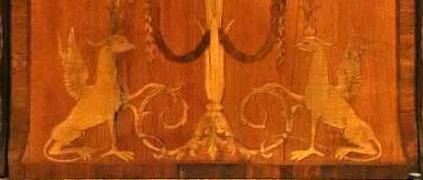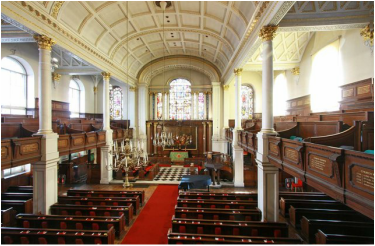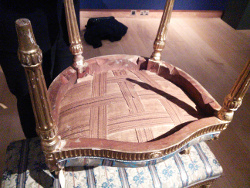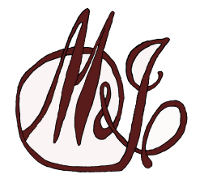|
There were a number of artisans in the Broad Street area in the late eighteenth century. Ince & Mayhew took over from Charles Smith in the cabinet-making trade in 1759 and were based at the western end of Broad Street in Marshall Street. When Thomas Sheraton produced his Cabinet Dictionary in 1803, there were four other cabinet-makers in Broad Street: Hudson and Corney at Nos.4 and 13, Jermain at No.10 Broad Street, Lonsdale at No. 7 and Owen an Upholsterer at No. 54.
Thomas Sheraton was himself living at 8 Broad Street where copies of the Dictionary could be obtained. It would be very surprising if he and William Ince did not meet occasionally to discuss the trade. Thomas Sheraton died in 1806 and the writer of his obituary in the Gentlemen’s Magazine was concerned that he had left his family ‘in distressed circumstances’ mainly because since 1793 he had been supporting himself as an author. He was described as ‘a very honest well-disposed man; of an acute and enterprising disposition’. Broad Street also housed a number of instrument makers: the harpsichord maker Jacob Kirckman, who came to England in the 1730s, had his business at No.19. He was organist of St. George's, Hanover Square, and the author of several compositions for the organ and the pianoforte which he published himself at the sign of the 'King's Arms' in Broad Street, Carnaby Market. He died in 1777 but the business was continued by his nephew, Abraham. There is record of a square piano inscribed Jacob and Abraham Kirchmann dated 1775 and a grand piano dated 1780 was also theirs[i]. Frederick Beck the piano maker was at No.4 Broad Street, producing square pianos between 1772 and 1788, with attributions to 1798. Thomas Beck, pianoforte maker was at the same address. Beck was also in business with George Corrie of 41, Broad Street about 1790[ii]. Christopher Ganer was a piano maker, inlayer, music publisher and seller initially at 22 Broad Street moving to 47 Broad Street, Soho and also at 48 Broad Street from the early 1780’s. From 1779, he made very elegant inlaid square pianos on a “French” frame stand as well as plain examples.[iii] William Blake, the painter and poet, was born at No. 74 (then No. 28) Broad Street and after his marriage in 1782 he set up in business as a print seller next-door in No. 72 (then No. 27), but had removed to Poland Street by Christmas 1785; his partner, James Parker, remained at No. 72 until 1794.[iv] The two sculptors and carvers, Sefferin Alken and Sefferin Nelson were based in Dufours Place, a little alley off the north of Broad Street. A National School was established in Marshall Street in 1827, described as situated at the end of Broad-street, Golden Square – the exact site that Ince & Mayhew bought from Charles Smith in 1758, as shown on the map in the Victoria County History[v]. Three school rooms were erected with apartments for the masters and mistresses plus a shop used as a depot for the Society for promoting Christian Knowledge. There were two day-schools and two evening-schools, separate for boys and girls, and an infant-school. There were over 1000 pupils in total. The school closed in 1892. [i] https://en.wikisource.org/wiki/A_Dictionary_of_Music_and_Musicians/Kirkman [ii] http://earlypiano.co.uk/2013/arnold-frederick-beck/ [iii] http://earlypiano.co.uk/2013/ganer-christopher/ [iv] http://www.british-history.ac.uk/survey-london/vols31-2/pt2/pp196-208#highlight-first [v] http://www.british-history.ac.uk/survey-london/vols31-2/pt2/pp196-208#highlight-first  I have been reading about the beautiful Rosebery Desk which was made by Ince & Mayhew around 1775 and was in the collection of the 5th Earl of Rosebery. It was sold by his daughter Lady Sybil Grant in 1956 to a private collector in Canada and later loaned to the Metropolitan Museum of New York. To see some photographs of this delightful piece, follow the link below. The desk has superb marquetry throughout and is described as ‘meticulously inlaid’[1]. It has an inlaid roll-top with a leather writing surface inside, with pigeon holes in satinwood and small drawers in burr yew, which flank a small mahogany painted cupboard door. The front has a drawer and a frieze which includes two wyverns with scaly fish tails. The desk is similar to the roll-top desk attributed to Ince & Mayhew at Syon House. The wyvern can be found on other furniture associated with Ince & Mayhew, and appear in heraldry. Two wyverns support the arms of the Dukes of Marlborough and are so depicted on the dedication page of the Universal System of Household Furniture. I wonder if William Ince had enjoyed drawing them and wanted to include them in some of his designs, though it may be that the design came originally from Robert Adam. [1] https://issuu.com/mallett/docs/21_the_age_of_matthew_boulton  Photo: John Salmon Photo: John Salmon Early on in my research I visited St George's Hanover Square in London. This is the church where John Mayhew and William Ince married the sisters Isabella and Ann Stephenson on 20th February 1762. The report in The London Chronicle refers to 'Nancy Stephenson', which lends an air of frivolity to her. All four signed the entries in the Parish Register, and the witnesses were John Mayhew's father and William Ince, for John and Isabella, and again John Mayhew's father and this time John Mayhew for William and Ann. The curate, Thomas Vincent, performed the service along with the other three marriages that took place that day. The marriages were permitted by licence, rather than the reading of Banns. As Nancy was only nineteen her mother signed a paper to confirm Nancy had no father living, and she gave her permission for the marriage to take place. Jean Stephenson wrote that she was too old and infirm to testify in person. As many a family historian will relate, to take time to sit quietly in the church where your ancestors were married is a moving experience. I found it good to ponder on their marriage, how young they all were, still in their teens and twenties, but presumably hopeful and excited about their future together. Sadly Isabella died within the year, but William and Nancy survived to the early nineteenth century, producing thirteen children, nine boys and four girls, of whom only six survived them.  Inverted Ince & Mayhew chair showing clamp notches 1774 Inverted Ince & Mayhew chair showing clamp notches 1774 I had a most enjoyable visit to Christie’s last week to see the giltwood armchairs and stools and the superb serpentine serving table made by Ince & Mayhew in the 1770s. It was a pleasure to meet some of the staff, including Charles Cator. They were very knowledgeable about the pieces and emphasised the quality of the furniture produced by the firm. I wondered if Ince & Mayhew had some sort of quality control, inspecting pieces before they were delivered to make sure the standard of workmanship was satisfactory. It was interesting to see the bottom of one of the chairs with the deep V-notches that were carved to allow clamps to hold the legs in place when they were being glued, necessary with the rounded backs. The Auction was held on 8th March and the armchairs were sold for £20,000, the stools for £25,000, nearly three times the estimate, and the table for £65,000, more than double the estimate.  Ince & Mayhew Seal Ince & Mayhew Seal The National Library of Wales owns two letters written by William Ince to Richard Myddleton at Chirk Castle, one on 3rd October, 1782 and the other on 11th September, 1783 (E5126-E5128). I was able to purchase digital copies of them for my research. Interestingly one sheet has the address written on it with the wax seal that was used to seal it. At first I thought the seal said I & M, then I realised that the letter had been folded so the seal should be read the other way up. Turning the photo round revealed a very clear M & I stamped on the wax. I have traced the lettering to create a rough impression of their 'logo', bearing in mind that the wax would have spread and that the letter is over two hundred and thirty years old. The I is very similar to the I in William Ince's signature and is cleverly wound round the front of the M. I am using a mini-version of the seal as the favicon for this website - the little icon on each page. |
Author
Sarah Ingle is the great great great great grand-daughter of William Ince and has been researching her family history for a number of years. She thoroughly enjoyed the detective work involved in tracing William’s lineage. Archives
December 2022
Categories |

 RSS Feed
RSS Feed